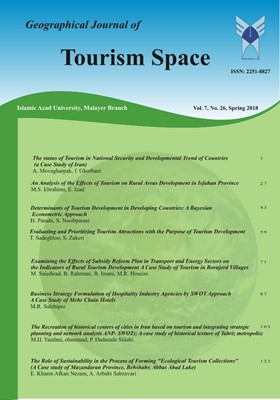Evaluating and Prioritizing Tourism Attractions with the Purpose of Tourism Development
Subject Areas :
SEDIGHEH ZAKERI
1
*
,
xx hh
2
1 - Geography,Literature and Humanities, Ferdowsi, Mashhad, Iran
2 - hh
Received: 2018-07-03
Accepted : 2018-07-03
Published : 2018-05-22
Keywords:
tourism development,
Mashhad,
tourist attractions,
multi-criteria decision making method,
Abstract :
Tourism industry because of its effect on providing job opportunities and the income level of people has an important role in the economy of a society. In order to increase the income, tourists must first be attracted and in order to have the benefits of tourism, the tourists’ prioritization in choosing their destinations should be determined. Since the majority of tourists in Iran are domestic ones because of limited foreign tourism, many domestic trips in Iran are religious visits to holy places such as Mashhad and Qom. The purpose of this investigation was to identify the priority of tourism attractions in Mashhad using entropy technique, VICOR and SPSS. This research was descriptive-analytic and the data were gathered using field research. The results showed that Imam Reza's shrine was the first priority of tourism attraction for the participants and the other tourist attractions stood later in the priority. So Mashhad has not been successful with the new attractions created for the development of tourism in this city.
References:
ابراهیم زاده، ع.، کاظمی نژاد، ش.ا. و اسکندری ثانی، م. (1390)، برنامهریزی استراتژیک توسعه گردشگری، با تأکید بر گردشگری مذهبی (مطالعه موردی: شهر قم)، مجله پژوهشهای جغرافیای انسانی، شماره 76، صص 141-115.
افتخاری، ع.ر.، پورطاهری،م، مهدویان، ف. (1390). اولویتبندی ظرفیتهای گردشگری مناطق روستایی شهرستان نیر، مجله جغرافیا و توسعه، دوره9،( شماره پیاپی24)، 38-23.
پاپلی یزدی، م.ح. و سقایی، م. (1385). گردشگری (ماهیت و مفاهیم) ، تهران: سمت.
تقوایی، م و مبارکی، ا. (1389). بررسی و تحلیل فضاهای توریستی شهر تبریز به منظور برنامهریزی توریسم در آن، نشریه علمی-پژوهشی جغرافیایی و برنامه ریزی ، شماره133.
تولایی، س. (1386). مروری بر صنعت گردشگری، دانشگاه تربیت معلم.
دیناری، ا. (1384). گردشگری شهری در (ایران و جهان). مشهد: واژگان خرد.
رحیمی، د و رنجبرستانی، م. (1391). ارزیابی و اولویتبندی جاذبههای اکوتوریسم(روستاهای هدف گردشگری استان چهارمحال و بختیاری)، مطالعات و پژوهشهای شهری و منطقه ای، سال چهارم، شماره14.
رهنمایی، م. ت. (1386). جزوه درسی جغرافیای توریسم، دانشکده ی جغرافیا دانشگاه تهران.
رهنمایی، م.ت.، منوچهری میاندوآب، ا. و فرجی ملایی، ا. (1390). تحلیل کیفیت زندگی شهری در بافت فرسوده شهری میاندوآب، مدیریت شهری، شماره 28.
زبردست، ا. (1380). کاربرد فرآیند تحلیل سلسله مراتبی در برنامهریزی شهری و منطقهای، پژوهشهای هنرهای زیبا، دانشگاه تهران، شماره10.
سلطانی، ز.، و نوری زمان آبادی، س.ه. (1389). ارزیابی توان محیطی شهرستان خوانسار به منظور توسعه توریسم (با استفاده از GIS)، فصلنامه تحقیقات جغرافیایی، شماره99.
ضیائی، م.، و داغستانی، س. (1389). تحلیل سلسله مراتبی جاذبههای تاریخی- فرهنگی شهرستان نیشابور، فصلنامه جغرافیا و توسعه، شماره 17.
فاضل نیا، غ.، کیانی، ا.، محمودیان، ح.ا. (1390). مکانیابی و اولویتبندی پارکهای شهری با استفاده از روش تحلیل سلسله مراتبی TOPSIS و سیستم اطلاعات جغرافیایی(مطالعه موردی: شهر الشتر)، پژوهشهای جغرافیای انسانی، شماره78، 152-137.
فرج زادهاصل، م. (1384). سیستم اطلاعات جغرافیایی و کاربرد آن در برنامهریزی گردشگری، تهران: سمت.
قالیباف، م.ب.، شعبانیفرد، م. (1390). ارزیابی و اولویتبندی جاذبههای گردشگری برای توسعه گردشگری شهری بر اساس مدلهای تصمیمگیری چند متغیره، فصلنامه تحقیقات جغرافیایی، شماره پیاپی 101.
کاظمی، م. (1385)، مدیریت گردشگری. تهران: سمت.
موحد، ع و دولتشاه، ص. (1390). بررسی ظرفیتهای گردشگری جهت توسعه گردشگری شهری در خرمآباد، فصلنامه جغرافیا و آمایش سرزمین، سال اول، شماره اول، 88- 102.
مومنی، م.، و صرافی، م. (1387). ساختار و کارکرد گردشگری مذهبی-فرهنگی و ضرورت مدیریت یکپارچه در کلانشهر مشهد. مجله جغرافیا و توسعه، شماره11.
نوری، ج.، زارعی، ه. و میرحسینی، ا. (1389). امکان سنجش جذب اکوتروسیم در مناطق کویری ایران (مطالعه موردی: تله کابین طرزجان). فصلنامه فضای جغرافیایی، شماره ی32، 75-93.
Brau, Rinaldo. And Cao,. Davide(2006). Uncovering the Macrostructure of Tourists Preferences. A Choice Experiment Analysis of Tourism Demand to Sardinia. http://www. Feem.it/Feem/Pub/Publications/WPapers/default. htm.
Cohen, E., (1978). The impact of Tourism on the Physical environment. Annals of Tourism Research, 5, 215-237.
Hong, Sung-kwon., Kim, Jae-hyun., Hochan., and Lee, Seokho. (2006). The roles of categorization, affective image and constraints on destination choice: An application of the NMNL model. Tourism Management 27: 750- 761.
Hall, C.M., Page, S. J.(2001). Tourism and Recreation. London: Routleadge.
Inskeep, E. (1994). National and Regional Tourism Development, Methodologies and Case Studies. London: Routledge.
Mason, P. (2003).Tourism Impacts, Planning and Management, Butterworth Heinman.
Mason, P., (1995). Tourism: Enviroment and development Perspectives. Godalming, UK, World Wide Fund for Nature.
Peter, P.D.(2005).Volunteer tourism posts modern pilgrimage in Tamilnadu. Journal of tourism and cultural change.
Philips, M.R. and House, C. (2009). An evaluation of priorities for beach tourism: Case studies from South Wales, UK. Tourism Management (30): 176- 183.
Sommer, a, Saviano, M.(2007). Spiritually Tourisms: Religiousness Raised in Deutschland, Berlin. Analytical on Role religious tourism in Urbanization Extention.
Williams, S., (2000). Tourism Geography. London: Routledge Publications.
(1995). Concepts, Definition and Classifications for Tourism Statistics. Madrid: World Tourism Organization Press.
WTTC:World Travel & Tourism Council (2013).
_||_

